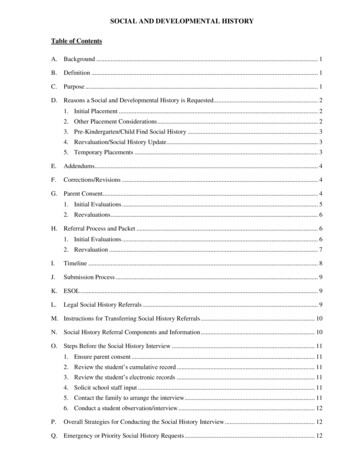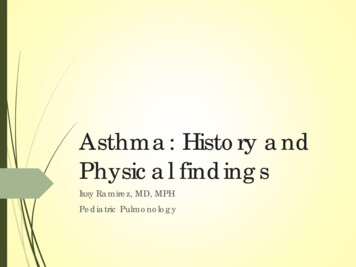
Transcription
History of Social Security1935-1975History is not was but is.--Hemingway
ZoomMic and Video offThanks to Zoom supportScott & CarrieQuestions in chat—break and end5-10 minute breakhalfway through
Health InsuranceA Federal Private Partnership
Quick Review Long term effort (TR 1912) effort for health insurance Truman 5-point goal for health care Hill-Burton Act—hospital buildings Eisenhower minor medically needy program Elderly hit hardest Less income Greater need for medical care
LBJ signs Medicarelaw with HarryTruman inIndependence, Mo7/30/65
A Three Layer Cake--FinancingHospital Insurance (A)—payroll taxesPhysician and other costs (B)—premium and generalrevenuesNeeds based medical for categorical eligible—sharedstate and federal
Hospital Insurance Trust Fund Originally Medicare taxes combined with SocialSecurity (FICA) 1965—3.625% on 4,800 1966—4.2% on 6,6000 Separated into a separate Trust Fund in 1991
Supplemental Medical Insurance-Voluntary Responded to allegations of socialized medicine Separate Trust Fund 3/month deducted from RSI, RRB, or Civil Service Retirement forover 65 Uninsured 65-year-olds could pay directly States could purchase insurance for welfare recipients Federal government matches all premiums from general revenue Deductible and copay to prevent overutilization
Medicare Additional Income No limited wage base for Medicare Taxes Additional taxes over 200,000 (2006) Part A premium if uninsured Part B premiums higher with higher income People not covered for title II are covered for Medicare Federal, state and local Government employees Railroad employees (Criteria possibilities for title II funding?)
Implementation 11 months to Implement Part A automatically enrolled Part B must sign-up Medicare card designed and issued
FirstMedicareCardHarry Truman
Recruitment of Doctors formany underserved areasAlmostImmediatePositiveImpactJoint Commission forAccreditation of HospitalsIncreased trainingprograms/studentsIncreased services available
Type of ServiceServicesAvailableAgencies OfferingMarch 66March 67Physical Therapy745Occupational Therapy28Speech Therapy314Medical Social Work210Home Health Aides2351
Feds Oversee Private Insurance Processes Title II over 65-Eligible for Medicare HCFA, now CMS: Sets standards for providers and suppliers Sets standards for Utilization and Quality Peer Review Private insurance (contractors) Process claims Enroll providers Reimburse providers and suppliers Audit individual provider costs Establish local coverage determinations
What are FiscalIntermediariesand Carriers? Medicare contracted with private insurersserving area to process claims Able to review local fiscal payment options A contract was established for each state Reimbursement review Medical coverage review Part A—Fiscal Intermediaries (Blue Cross) Part B—Carriers (Blue Shield)
Life Expectancyat 651960 Men-12.8 years Women-15.8 years2019 Men 17.9 years Women-20.8 years
Civil Rights and Medicare Title VI of Civil Rights Act Facilities participating in Federal programs must not discriminate Fourth Circuit Court of Appeals supported Medicare requirements Room and ward assignments Admission of physicians to hospital staffs
72 Amendments—Disabled and Catastrophic Major Medicare impact—covers disabled after 24 months Greatly expanded the number of people covered Just before passed added End Stage Renal Disease (ESRD) Only recently accepted technology/treatment for dialysis andtransplant Estimates of cost uncertain Estimated costs only included under 65
Bills introduced for Dialysis 1965 to 1972 Kidney treatment centers growing VA established 30 treatmentcenters PHS programs supported NIH grants supported By 1972 10,000 patients dialyzed
1970 Ted Kennedy discussingNational Health Insurance Republicans supportedcatastrophic health insurance Senate added to Social Security billlater in 1972 Originally general funding Added to Medicare politically
ESRD implementation Focus—how much payroll tax? Needed to be currently insuredor auxiliary of currently insured Expected national HealthInsurance to be enacted inseveral years First approval of catastrophichealth insurance
Additional Coverage 1982 hospice care for elderly 2001 ALS for all ages covered 2003 self-administeredprescription drugs A number of expansionsinternal to CMS policy
Fiscal Changes—MMA of 2003 Beneficiaries with income less than 150% of theFederal Poverty Level are subsidized under Part D Beneficiaries with higher income pay a larger premium IRS Adjusted Gross, not net
Private Partnership Strengthened Medicare Prescription Drug, Improvement, and ModernizationAct of 2003 (MMA)—Drug Coverage Part C—Medicare Advantage Private insurance that combines with federal A&B Part D—Prescription Drugs some retain insurance through VA, former employer, or union
000One in threeAmericans arecovered by titleXVIII or XIX
Supplemental SecurityIncomeWelfare Reform
Unwillingness of Elderly to Apply for Assistancesocial insurancepublic assistance Positive Concept of self-help Connection with labor market Amount determined by Negative concept of Need What does not have Inability to maintain self or family unstated concept ofworthiness/unworthiness Amount earned/taxes paid How long worked
Design for Dignity Approach to “welfare mess” Conversion of 3.3 million welfare recipients Complex systems integration Dealing with people felt threatened (employees and recipients) Thought 3 million more might be eligible, Many elderly receiving small SS payments Politics on outreach Complex state relations/agreements Assumptions other categories would be federalized
Replaced Federal/State matchinggrant program (titles I, IV, X and XVI)WelfareReform—From State toFederal Effective 1/1/74 Needs based cash assistance tocategories: Aged, Blind, or Disabled(including children) With Limited income andresources Financed by General Fund States must/may supplement Linked to Medicaid (title XIX)
SSAAdministered National standard requirements for income andresource floor Means tested Proof of income/resources Complex decisions on living arrangements SSA data alerts for income sources (i.e., IRSand Earnings Record) Objective and Consistent No liens No Family Responsibility No discrimination
States Retain Many responsibilities Social Services—title XX Medicaid—title XIX Federal impact on state budgets Issues on who does disability determination for children In Virginia: Medicaid state definition of disability beyond SSI Choses to administer own SSI State supplement
1. Social Security2. Private/government pension (VA, state,union, employer)EconomicSecurity forthe elderlyA. Employee Retirement Income Security Actof 1974 (ERISA)1) Administered by Pension Benefit GuaranteeBoard2) Pay 800,000 retirees from 5,000 terminatedsingle-employer pension plans3. Savings, including home ownership4. SSI
SSI—PreventPoverty Title XVI—goal: provide basic food, clothingand shelter Many elderly have low benefits Insurance concept not sufficient for parttime or infrequent workers Young disabled low benefit or uninsured Title XIX—Parents of disabled childrenmedically needy
Eligibility Differences Title II Title XVI Replaces income lost because of retirement,disability, or death Means Tested Relationship to worker/his SSN Social Insurance Lose benefits only if: Recover from disability Auxiliaries have change of status Disability definition work oriented Payment for prior month Paid on own SSN Funded by general revenue Lose benefit if income and resources goabove defined levels Disability definition primarily medical Payment 1st of month for future month
Recipients—in MillionsTotalSocial SecurityonlySSI onlyBoth Social Securityand SSIAll beneficiaries69,78161,8945,2732,613Aged 65 or older50,85848,5789951,285Disabled, underage 6512,9927,3854,2781,328Type of beneficiary
SSA Accountingand ExpendituresTrust Fund and General Revenue
SSA MustAccount forProgrammaticandAdministrativeCosts Benefit Payments Cost of administration Purchase of medical records/tests Medical Consultants Office space and equipment Employee salaries External Requests--charge Freedom of Information Act (size) Administer other programs SSN verifications forauthorization to work DMV
Principal—Must relate toSSAResponsibilities Administering Programs Provide information to otheragencies required by law Maintaining Records needed toadminister programs Wages SSNs SSI income and resources
Death Master File Created for Administration of Benefits People over 65 or receiving benefits, SSN information Contains state death record info (SSA does not own) Must make SSA info available under Freedom of Information Act Dept of Commerce National Technical Information Services Sells public file for cost (financial organizations, ancestry) Excludes state death record information
IssuesNo Easy Answers
OASDI Trustees Report for end of 2019 RSI Fully funded into 2034 Able to pay 76% thereafterSolvency DI Fully Funded 2065 Able to pay 92% thereafter HI Fully Funded until 2026 Lower because of repeal of HI excise tax SMI at least 10 years
Solvency Options COL Adjustments Computation of Monthly Benefits, includingadjustment for age Benefits for Family Members Payroll Taxes, including maximum taxable Expanding Coverage or Earnings Investment in Marketable Securities Taxation of Benefits
Women/Men’s issuesFairnessOffset of other pensionsRegressiveObjective nature of disability decision
Women’s Issues Women working as full-time members of workforce 1939—25% of workforce (often parttime or irregularly) Insurance concentrated on loss of husband’s wages Unfair treatment compared to women who do not work (not workers) 1976—40% of workforce 2019—47% of workforce 2019—54.7% of women and 69.2% of men in workforce Multiple marriages and divorces
Advantages to women as workers Can retire with benefits on own without regard to husband Potential Medicare with retirement/disability Children get benefits from deceased/disabled mother Disability benefits—as widow only age 50
Have one member pay a premiumsurcharge to insure spouses andchildrenTwo WorkerCouples—Solutions?Allow FICA refunds for combinedpayments over a certain amount as donow when more than one employerand pay more than maxTo pay both worker and spousalbenefits to both would be expensive!
Notches A notch or cliff occurs when legislation or processes have anegative effect on some people based on designatedfactors such as birth year. Almost any change has potential to be a notch SSA has been trying for “slopes” rather than notches Increasing full retirement to 67 rather than 65 life expectancy gives many more years of benefits
“The” Notch Benefits paid to people born 1917-1921 1972 law on annual COL Formula flawed—benefits rise faster than COL People born 1910-1916 received windfall Congress corrected error 1977 Calculations 1917-1921 used both, paid higher 1994 Commission said benefits paid to notch years were equitable
2008 notch 2008—economic downturn Benefits tied to high 35 years Computation tied to average wage index (AWI) Corrects for changes to wage growth Earnings lower in 2008 resulted in benefits 1/month lowerrest of life for people who turned 60 in 2008 (born 1948)
Covid impact—2020 Notch 2020 average wage estimated severely down SSA Chief Actuary estimated 9.1% For those turning 60 in 2020 119/month reduction for life Options before congress When AWI results in lower benefit, use prior year Legislation pending
WEP and GPO Government Pension Offset--1977 Result of SC decision giving men same auxiliary benefits as women Applies to eligibility as well as receipt Amount of pension will be subtracted from potential SS benefit Federal, state or subdivision of state Excludes Workers Comp and VA benefits Windfall Elimination—Phased in 1986 to 1990 Eligible for a pension in non-covered employment Revised benefit formula to prevent windfall based on weighting
Return onInvestment Nature of Insurance Privatization—came close Disability and survivorinsurance Full Market Cycle
ConclusionsHow did we get here?
Passage of the Social Security Act Desperate Times Passed Congress with large majority BUT Fear of Constitutionality issue Commitment of two people Frances Perkins FDR
Individual Responsibility and Social Need Social Insurance Compulsory Based on individual payroll taxes Personal commitment by earmarked taxes Concern for general welfare Computation mildly regressive to benefit lower wage earners Considers needs of family
Federal orstate/local? Church and volunteerism not sufficient inhard times Industrialization/wage-based societycreates vulnerabilities Doesn’t remove local involvement Consistency Portability from job to job, state to state Efficiency in numbers (1 or 50 entities) Partnership Constitutionality may remain an issue
Future of Social Security Solvency Privatization Personal Service/automation Loss of faith by young workers Did Hoover have it right?
Thank You!
Hospital Insurance Trust Fund Originally Medicare taxes combined with Social Security (FICA) . Choses to administer own SSI State supplement. Economic Security for the elderly 1. Social Security 2. Private/government pension (VA, state, . 1994 Commission said benefits paid to notch years were equitable. 2008 notch 2008 .










